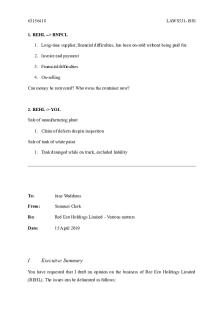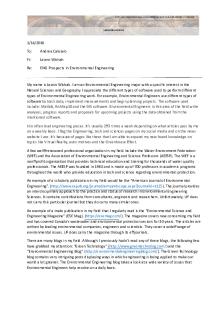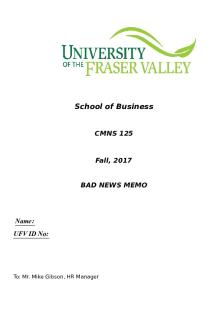ENGL- Document 9 - Mandatory assignment in memo format about the watercycle PDF

| Title | ENGL- Document 9 - Mandatory assignment in memo format about the watercycle |
|---|---|
| Course | Technical Writing |
| Institution | Ivy Tech Community College of Indiana |
| Pages | 3 |
| File Size | 123.5 KB |
| File Type | |
| Total Downloads | 75 |
| Total Views | 123 |
Summary
Mandatory assignment in memo format about the watercycle...
Description
To Incoming Members to IUS Science Club From Stephanie Doyle Date April 28, 2018 Subject
Definition and Definition of the Water Cycle
The Water Cycle is a process of how water evaporates from the surface of the earth, rises into the atmosphere, condenses into rain or other water products into clouds, and falls onto the surface as precipitation. When the water finally returns to the surface, the process repeats over again. This is a brief explanation to show the incoming members to the IUS Science Club some of the material that we go over in the club and an example of how to write an explanation to prepare for Chemistry classes or other sciences classes on campus that may be required as a general education course. Evaporation The Water Cycle consists of three major processes, evaporation, condensation, and precipitation. The first step is evaporation. This is the process where water turns from a liquid into a gas from the earth's surface and rises (evaporates) into the atmosphere turning into water vapor. This generally happens from Oceans, Lakes, or Streams on earth. Water vapor is a greenhouse gas, and as it rises into earth’s atmosphere, it helps keep our planet heated so that life is sustainable on earth. The evaporation process is only possible because of earth’s sun. As the sun interacts with bodies on water on the planet's surface, the water turn into a gas (water vapor) and evaporates.
https://pmm.nasa.gov/education/water-cycle
Condensation The second step in the Water Cycle is condensation. This process occurs when the water vapor (gas) reaches the earth’s atmosphere and condenses back into a liquid. Condensation can occur high in the atmosphere or at ground level. Clouds form as the water vapor condenses or becomes more dense. Cloud condensation nuclei (CCN) are tiny particles that water vapor condenses around. CNN can be specks of dust, salt, or pollutants and clouds at ground level are known as fog or mist. Like evaporation, the sun also influences condensation. As the water vapor cools, it reaches its saturation limit, or dew point. The air pressure also plays an important role in condensation as well as it influences the saturation limit or dew point. Precipitation The third step in the water cycle is known as precipitation. Now unlike the first two step, evaporation and condensation, precipitation is not a process. Precipitation is described as any liquid or solid that falls to the earth's surface as a result of condensation in the atmosphere. This includes rain, snow, or hail. Although rain, snow, and hail are parts of precipitation, fog is not. The water in fog does not actually precipitate, or liquify and fall to earth. Fog and mist are part of the Water Cycle known as suspension; they are liquid water suspended in the atmosphere. Precipitation is one of the many ways water is cycled from the atmosphere to the earth's surface. In conclusion, there are three major processes in the Water Cycle, evaporation, condensation, and precipitation. Although precipitation is not a process, it is still a vital part to explaining the cycle. Evaporation is the process of how water turns into a gas and enters the earth’s atmosphere; condensation is the process of the gas condensing back into liquid water, and precipitation is described as liquid water falling back to the surface due to condensation as rain, snow, or hail.
References The Water Cycle. (n.d.). Retrieved from https://pmm.nasa.gov/education/water-cycle National Geographic Society. (2012, October 09). Water Cycle. Retrieved from https://www.nationalgeographic.org/encyclopedia/water-cycle/...
Similar Free PDFs

Memo - Business Memo Assignment
- 2 Pages

Vancouver - format document
- 6 Pages

Assignment MANDATORY
- 3 Pages

assignment mandatory
- 38 Pages

Memo assignment
- 10 Pages

Memo 1 - Memo 1 Assignment
- 2 Pages

The Truth About Lying Assignment
- 4 Pages
Popular Institutions
- Tinajero National High School - Annex
- Politeknik Caltex Riau
- Yokohama City University
- SGT University
- University of Al-Qadisiyah
- Divine Word College of Vigan
- Techniek College Rotterdam
- Universidade de Santiago
- Universiti Teknologi MARA Cawangan Johor Kampus Pasir Gudang
- Poltekkes Kemenkes Yogyakarta
- Baguio City National High School
- Colegio san marcos
- preparatoria uno
- Centro de Bachillerato Tecnológico Industrial y de Servicios No. 107
- Dalian Maritime University
- Quang Trung Secondary School
- Colegio Tecnológico en Informática
- Corporación Regional de Educación Superior
- Grupo CEDVA
- Dar Al Uloom University
- Centro de Estudios Preuniversitarios de la Universidad Nacional de Ingeniería
- 上智大学
- Aakash International School, Nuna Majara
- San Felipe Neri Catholic School
- Kang Chiao International School - New Taipei City
- Misamis Occidental National High School
- Institución Educativa Escuela Normal Juan Ladrilleros
- Kolehiyo ng Pantukan
- Batanes State College
- Instituto Continental
- Sekolah Menengah Kejuruan Kesehatan Kaltara (Tarakan)
- Colegio de La Inmaculada Concepcion - Cebu








